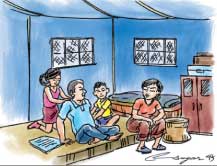Disaster-hit people
The devastating earthquake of 7.6 magnitude on 25 April struck caused huge loss of lives and property. The level of damage is still increasing due to frequent aftershocks. There is overwhelming support from the international community for emergency response to this tragic earthquake. The first phase of emergency response, i.e. search and rescue, is almost complete and relief distribution is going on. Many communities are desperately seeking emergency relief items. Temporary shelters are still problematic in many areas, and there is a strong need to look into the water supply, sanitation and hygiene. Effective management of debris and solid wastes should also be managed. The vulnerable people—children, women, the elderly, people with disabilities and marginalized people—are in great need for emergency response and relief aid.
Many government and humanitarian agencies have been involved in emergency response and relief distribution, including overall risk reductions, since many years in Nepal. However, for effective and efficient response, humanitarian agencies/practitioners should have sound knowledge and skills regarding humanitarian standards so that they are able to provide quality assistance and are accountable to the beneficiaries for their actions. During the peak emergency period, it might be overambitious to maintain all the humanitarian standards, but it’s their responsibility to ensure the right to life with dignity of the earthquake affected people. The Government of Nepal is widely being berated for its one door policy for relief distribution. This is because Government of Nepal has put less efforts into preparedness to respond.
It is the responsibility of government and humanitarian practitioners to ensure the right to live with dignity of all disaster affected people. Globally agreed standards, Sphere standards and its companions can be used according to our local context
However, the one door policy is appropriate to ensure that the humanitarian aid is transparent and accountable. The haphazard ways of relief distribution and less consideration of the right to life with dignity are observed at this time. Communities are desperately seeking emergency response, but the government is busy holding meetings lacking appropriate decisions. Communities in dire need of tents for shelter are getting noodles instead. Vulnerable communities who are highly affected are not getting relief materials equivalent to some privileged groups who are getting more benefits. Relief materials should be distributed on the basis of what the exactly community needs and not what humanitarian agencies have. The affected people have the right to get humanitarian assistance and, while providing relief materials, they should not be ill-treated. It is, therefore, necessary that when any natural disaster occurs the right to life with dignity should be of prime concern.
This tragic earthquake also opens various ways of learning how developing countries like Nepal can better cope with such challenges. A new disaster management act with proper policy; effective coordinating body establishing separate disaster management authority and promotion of local resources for effective response mechanism are of utmost importance. Human resources and research culture on earthquakes and similar other disasters should be promoted. Now, the nation has to focus on efficient and effective recovery process and the livelihood of the communities should never be undermined.
Globally, various humanitarian responses have been practiced. Sphere project is one good way of securing the right to life with dignity of the disaster affected communities. It is globally agreed to establish the minimum standards of humanitarian response. Sphere philosophy is based on two core beliefs: first, that those affected by disaster or conflict have a right to life with dignity and, therefore, a right to assistance; and second, that all possible steps should be taken to alleviate human suffering arising out of disasters or conflicts. This Sphere covers main components like food and nutrition, shelter, settlement and non-food items and health. Water and sanitation are critical areas for survival in the initial stages of a disaster.
People affected by disasters are generally much more susceptible to illnesses and death from diseases, which to a large extent are related to inadequate sanitation, inadequate water supplies and inability to maintain good hygiene practices. The handbook of Sphere standard emphasizes good hygiene practices, the provision of safe drinking water, the reduction of environmental health risks and the conditions that allow people to live with good health, dignity, comfort and security.
For example, 7.5 litres to 15 litres water are the minimum standards of water for survival. Similarly, 250 people per tap based on a flow of 7.5 litres/minute should be established. In Sphere, key indicators can be contextualized as per the local situation and need. During emergencies, education is also an important part where global children’s charter emphasizes that schools must be safe and education must not be interrupted. Like Sphere, Inter-Agency Network for Education in Emergency (INEE) is a handbook that deals with minimum standards regarding education.
In a nutshell, it is the responsibility of government and humanitarian practitioners to ensure the right to live with dignity of all disaster affected people. Globally agreed standards, Sphere standards and its companions can be used according to our local context.
Sharma is lecturer at Central Department of Environmental Science, Tribhuvan University






